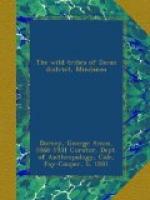Only a few of the weavers attempt to make the peculiar chocolate-colored head covering worn by the magani. For these kerchiefs the woman weaves a square cotton cloth of the desired size, and at one corner attaches a small brass hook. Joined to the hook, by means of a chain, is a loop which fits over the toes of the operator, thus enabling her to keep the fabric taut while her hands are left free for work. Small sections of this cloth are raised and are wrapped with waxed thread, so that when the fabric is dyed these portions will not receive the coloring matter (Plate XXV). Later the overtying is removed, leaving small white rings or squares on a chocolate-colored background. These cloths are meant primarily for the warriors, but expert weavers, who are under the protection of a certain powerful spirit, are also permitted to wear an upper garment of this material.
A considerable part of the man’s time is consumed in preparation for, or actual participation in, hunting or warfare, but in addition to this he does a goodly portion of the work in the fields, and is the house builder. When a man is about to erect a dwelling he notifies his friends to come and aid him. This they will do without pay, but when in need of similar services they will expect and will receive similar help. All sorts of house-furnishings, such as spoons, meat blocks, or rice mortars are made by the man, and not infrequently, he assists in the making or waterproofing of baskets. A few of the old men of Cibolan still engage in the manufacture of small shell disks with which valuable suits are decorated, but the greater part of those now in use have been inherited, or are purchased from neighboring peoples. The men carve beads out of “Job’s tears"[1] and make them into necklaces. For this purpose a peculiarly carved and decorated stick is employed (Plate XXVI). This is placed in the palm of the left hand so that the thumb and forefinger can hold the seed which fits into a depression in the top. A knife in the right hand of the artist is worked over the seed thus cutting a line into which dirt is rubbed. Women’s combs are made by shaping a half circle out of light wood and then cutting teeth into it with a saw-like blade of tin or iron.
[1] Coix lachryma Johi L.
Among the men, as with the women, certain industries are monopolized by a few individuals. In this community no men stand higher in the estimation of their fellows than do the smiths and the casters of copper. The writer spent many hours watching I-o, the brass and copper worker of Cibolan, while he shaped bells, bracelets, and betel boxes at his forge on the outskirts of the village (Plate XXVII). Feathered plungers, which worked up and down in two bamboo cylinders, forced air through a small clay-tipped tube into a charcoal fire. This served as a bellows, while a small cup made of straw ashes formed an excellent crucible. The first day I watched I-o, he was




